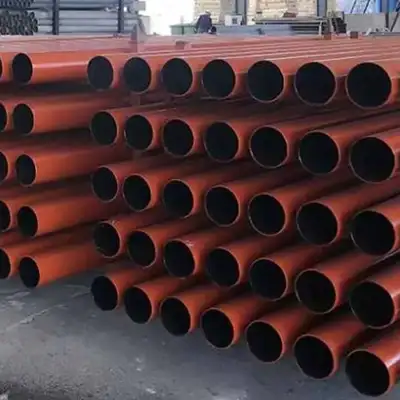I often encounter cast iron pipe—whether in century‑old sewer stacks or mid‑20th‑century drains. These pipes are durable, but when repairs or rerouting are needed, cutting them properly matters. If done poorly, you risk cracking, misalignment, or safety hazards. Over my 15‑year career, I’ve refined the best approach. In this article, I’ll walk you through my proven, efficient method.
1. Common Tools for Cutting Cast Iron
I’ll start by discussing the five key tools pros use:
-
Chain (Snap) Soil‑Pipe Cutter – Manual or ratchet style; wraps around pipe, then snaps it cleanly. Fast, clean cuts in tight spaces; very common in plumbing.
-
Reciprocating Saw (Sawzall) – With carbide‑tipped or diamond‑grit blade; cuts straight through, quiet and controlled.
-
Angle Grinder with Abrasive/Ceramic Disc – Fast, but creates sparks and dust; less precise unless stabilized.
-
Diamond‑Edge Disc Cutter – A specialist disc or wheel on grinder; cleaner, less dust and sparks.
-
Hacksaw – Low‑tech, only for small jobs; laborious and slow.
2. Tool Comparison Table
| Tool | Speed | Cut Quality | Dust/Sparks | Tight‑Fit Usability | Best Use Case |
|---|---|---|---|---|---|
| Chain Cutter | ★★★★☆ | Clean | None | Excellent | Crowded stacks |
| Recip Saw | ★★★☆☆ | Straight, controlled | Low | Good | Long, straight runs |
| Grinder + Abrasive Disc | ★★★★☆ | Rough | High sparks | Moderate | Open, fast cuts |
| Grinder + Diamond Disc | ★★★☆☆ | Cleaner | Moderate | Moderate | Clean open cuts |
| Hacksaw | ★★☆☆☆ | Fair | None | Poor | Occasional, small cuts |

3. My Step‑by‑Step Technique
3.1. Prepare
-
I clean the surface and secure the pipe with a vise or chain clamp.
-
I wear gloves, dust mask, goggles, and hears—and ensure good ventilation (per OSHA standards).
3.2. Choose the Tool
-
In cramped spaces, I go for a chain cutter; in open areas, a recip saw with carbide blade gives a straight line.
3.3. Cut the Pipe
-
Chain Cutter: Wrap, ratchet tight, then rotate handle until it “snaps” the pipe.
-
Recip Saw: Use two‑handed grip, plunge the blade fully through. A 9″ Lenox carbide blade eliminates bounce.
-
Angle Grinder: Steady sweep; avoid overheating. Use diamond‑edge disc for cleaner results .
3.4. Deburr & Clean
-
Use a wire brush or nylon pad inside and out.
-
For cast iron, typically a Fernco rubber coupling is used to join once cut.
4. Case Study: 80‑Year‑Old Sewage Stack
A few months ago, I worked on an 80‑year‑old apartment building in Chicago. The sewer stack, thick-walled and brittle, needed a 2‑foot section removed and replaced with ABS.
-
I tried a chain cutter first, but the pipe chipped beyond the cut—due to its brittleness—confirming peers’ advice.
-
So, I switched to a Sawzall with a carbide blade; it made a precise cut with little vibration.
-
I then used a diamond wheel on an angle grinder to square the edge, cleaned, and fitted with Fernco coupling.
-
Total job time: 45 minutes. No cracks, and perfect seal.
This reinforces: chain cutters are fast—but not always safe for very old cast iron.
5. Safety & Technical Standards
-
OSHA 29 CFR 1910.132: General PPE standards for eye protection, respirators, gloves.
-
ANSI B7.1‑2019: Tool guard and wheel safety for abrasive wheels and grinders.
-
ASTM A377: Specifies mechanical properties for cast iron pipe.
Following these standards avoids hazards. I never skip PPE, always inspect discs for cracks, and never exceed max RPM—as ANSI mandates.
6. Frequently Asked Questions
Q1. Can I use a chain cutter on any cast iron pipe?
A: It works great for sound pipes. But for brittle, aged cast iron (40+ years), the force may cause fractures elsewhere . Use it carefully and inspect before cutting.
Q2. What blade is best for a reciprocating saw?
A: Choose a 9″ carbide‑tipped blade (e.g., Lenox) made for cast iron metals. It slices cleanly, with less heat than diamond grit blades.
Q3. How do I reduce dust and sparks?
A: Use a diamond-edge disc if you’re using a grinder—it creates less dust/sparks. Always work in ventilated area and wear respirator.
Q4. Is the angle grinder faster than a reciproc saw?
A: Speed-wise, yes—abrasive discs are fast—but less accurate and heavier dust. A reciproc saw is slower but more precise.
Q5. How should I join the pipes after cutting?
A: Ream and clean the ends, then use a Fernco rubber coupling for cast‑iron‑to‑plastic transitions. Ensure bands are evenly tightened.
7. Conclusion
I’ve cut thousands of feet of cast‑iron pipe. My go-to? Reciprocating saw with a carbide blade, offering precision, safety, and control. Chain cutters are fast, but risky on old pipes. Angle grinders are efficient but messy and require more PPE. Follow safety standards, prep properly, and your cuts will be clean, smooth, and safe.

